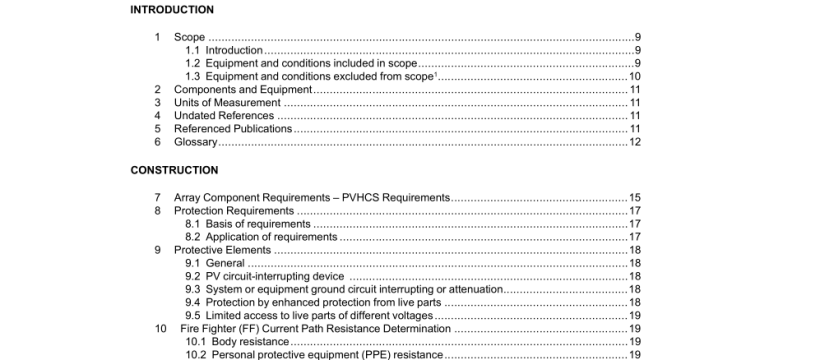UL 3741-2020 pdf download.Photovoltaic Hazard Control.
1.3 Equipment and conditions excluded from scope 1 1.3.1 The evaluation does not include equipment where the hazard control systems or functions have been rendered ineffective due to physical damage not specifically addressed in this standard. Examples of physical damage not addressed are the direct exposure of components to fire, smoke, high-pressure hose spray, or major systemic physical damage such as building collapse, destruction or removal of the array. NOTE: See Section 12.3 for the fire fighter (FF) interactions, including handheld hose lines, specifically addressed by this standard. Firefighting Monitors are controllable high capacity water jets that operate at higher pressures and volumes which can result in mechanical or structural damage to equipment and are therefore excluded from the scope of this standard. 1 Additional installation requirements addressing rapid shutdown of PV system circuits can be found in the National Electrical Code (NEC), NFPA 70, Section 690.12, Rapid Shutdown of PV Systems on Buildings, and the Canadian Electrical Code (CE Code) C22.1 64-218 requirements. 1.3.2 While this standard accounts for fire fighters (FF) wearing new or serviceable used PPE, it does not include consideration for any damage to PPE that occurred prior to fire fighter (FF) interaction with the PV array. NOTE: Standard operating procedures is to replace damaged fire fighting PPE. 1.3.3 The use of extinguishing agents not specified in this standard, such as seawater or high foam concentrations, are not included in the evaluation. NOTE: The requirements and resistance data in this standard are based on expected practices and are considered to provide information sufficient for performing a safety analysis. 1.3.4 These requirements do not replace any electrical safe work practices for persons installing, servicing or maintaining the PV system.
2 Components and Equipment 2.1 A component of a product covered by this standard and systems, including equipment evaluated by this standard, shall comply with the requirements for that component or equipment as specified in this Standard. A component and equipment shall comply with the CSA or UL standards as appropriate for the country where the product is to be installed. 3 Units of Measurement 3.1 Values and their respective units of measurement that are stated without parentheses constitute the requirement of the standard and those in parentheses constitute explanatory or approximate information. 4 Undated References 4.1 Any undated reference appearing in the requirements of this standard shall be interpreted as referring to the latest edition of that standard. 5 Referenced Publications 5.1 The following standards are referenced in this standard, and portions of these referenced standards may be essential for compliance. Some of the standard references are country specific depending upon whether or not the PV system is intended for installation in the Unites States, in Canada, or both.
6.17 PV HAZARD CONTROL COMPONENT (PVHCC) – A component of a PVHCS. PVHCC are often incomplete but may serve a function related to compliance of PVHCS. Examples may include the physical barriers associated with Enhanced Protection. 6.18 PV HAZARD CONTROL EQUIPMENT (PVHCE) – A complete piece of equipment evaluated for compliance with this standard (in addition to other applicable normative standards in Section 5) that performs function (s) related to reduction of electric shock hazards for FFs performing their work in the vicinity of the PVarray. 6.19 PV HAZARD CONTROL SYSTEM (PVHCS) – Systems of one or more PVHCE and other specific or generic specified PVarray equipment that have been evaluated to comply with the system requirements of this standard when installed in accordance with the manufacturer’s installation instructions. 6.20 VOLTAGE, PVHC MAXIMUM CIRCUIT (PVHC Maximum Circuit Voltage) – The highest voltage within a PVHCS that is available after PVHCS actuation which may take action to segment a PV string or array. Where applicable, this voltage includes temperature correction for photovoltaic module maximum open-circuit voltage based upon the lowest rated PVHCS operating temperature. If it is not otherwise defined in the specific PV module ratings the PVHC Maximum Circuit Voltage is 1.25 times the rated PV module Voc at Standard Test Conditions (STC). NOTE: The PVHC Maximum Circuit Voltage will be the same as the NEC 690.7, PV maximum system voltage if the PVHCS does not segment the PV array. Some PVHCS partition an array or string into multiple segments which are less than the PV Maximum system voltage.UL 3741-2020 pdf download.
UL 3741-2020 pdf download
